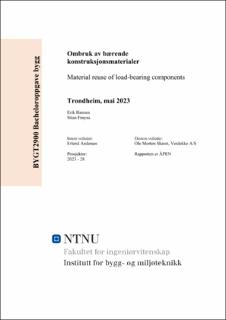| dc.contributor.advisor | Andenæs, Erlend | |
| dc.contributor.advisor | Skaret, Ole Morten | |
| dc.contributor.author | Frøysa, Stian | |
| dc.contributor.author | Hansen, Erik | |
| dc.date.accessioned | 2023-07-19T17:19:57Z | |
| dc.date.available | 2023-07-19T17:19:57Z | |
| dc.date.issued | 2023 | |
| dc.identifier | no.ntnu:inspera:146719958:51863263 | |
| dc.identifier.uri | https://hdl.handle.net/11250/3080338 | |
| dc.description.abstract | Sammendrag
I denne rapporten fokuseres det på betydningen av sirkulærøkonomi i byggebransjen og hvordan det kan bidra til å redusere klimagassutslippene. Denne bransjen er en av de største kildene til klimagassutslipp, særlig på grunn av utvinning, produksjon av materialer og det store uttaket av råstoff fra naturen. Ombruk av materialer og bygningskomponenter kan derfor være en viktig måte å redusere klimagassutslippene på, og samtidig minimere uttaket av råstoff fra naturen.
Rapporten tar utgangspunkt i et rehabiliteringsprosjekt som allerede har høyt fokus på ombruk av materialer, og skal oppfylle blant annet FutureBuilt-kravene om ombruk og ombrukbarhet. Dette krever at 50 % av vekten til bygget over bakken skal bestå av ombrukte eller ombrukbare komponenter (FutureBuilt, 2020). Studien baserer seg på ombruk av bærende konstruksjoner, og undersøker hvilke alternative løsninger som kan bedre klimagassutslippet.
Resultatene viser at ombruk av byggematerialer er svært gunstig for å redusere klimagassutslippene. Spesielt ombruk av stålkomponenter og hulldekke gir betydelige reduksjoner i CO2-utslipp. Ved å ombruke 18 % av stålet i konstruksjonen vil prosjektet redusere utslippet med 9,7 tonn CO2 eq. Ombruk av hulldekke fremfor nytt massivtre vil redusere utslippene med 6,8 tonn CO2 eq.
Studien viser at sirkulærøkonomi kan ha betydelig innvirkning på klimagassutslippene i byggebransjen. Selv om kunnskapsnivået innenfor feltet må økes og de økonomiske barrierene må løses, kan man ut ifra resultatene i denne rapporten se et stort potensial for reduksjon av klimagassutslipp. Derfor kan ombruk av bærende konstruksjonsmaterialer være en viktig strategi for å nå de internasjonale klima- og bærekraftsmålene. | |
| dc.description.abstract | Summary
This report focuses on the importance of the circular economy in the building industry and how it can contribute to reduce greenhouse gas emissions. The industry is one of the main sources to greenhouse gas emissions, mainly due to the extraction, production of materials and the significant extraction of raw materials from nature. This is why reuse of materials and building components could be an important way to reduce greenhouse gas emissions, and at the same time minimize the extraction of raw materials.
The report is based on a rehabilitation project that already highly focuses on reusing materials to meet, among other things, the FutureBuilt requirements for reuse and recyclability. This requires that 50 % of the buildings weight above ground must consist of reused or recyclable components (FutureBuilt, 2020). This study focuses on the material reuse of load-bearing components and examines alternative solutions which can improve greenhouse gas emissions.
The results shows that reusing building materials is highly beneficial in reducing greenhouse gas emissions. In particular, the reuse of steel components and hollow core slabs provides significant reductions in CO2 emissions. By reusing 18 % of the load-bearing steel components, the project will reduce CO2 emissions by 9.7 tons CO2 eq. By replacing the solid wood elements with reused hollow core slabs, emissions will drop 6.8 tons CO2 eq.
The study shows that the circular economy can affect greenhouse gas emissions in the building industry significantly. Even if the knowledge within reusing materials must improve and the economy barriers needs to be solved, these results show a great potential for reducing greenhouse gas emissions. This is why material reuse of load-bearing components, could be an essential strategy for achieving the international climate and sustainability goals. | |
| dc.language | nob | |
| dc.publisher | NTNU | |
| dc.title | Ombruk av bærende konstruksjonsmaterialer | |
| dc.type | Bachelor thesis | |
